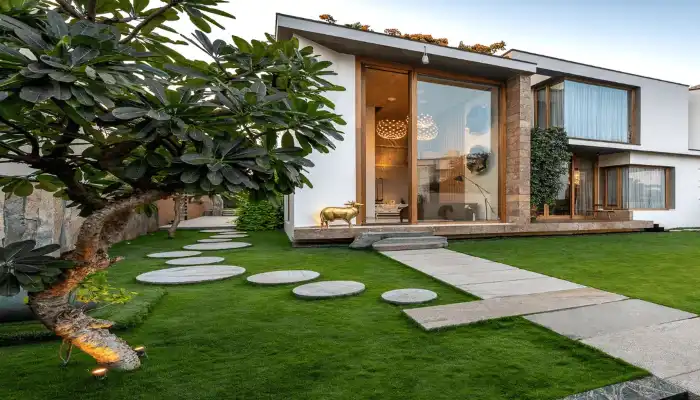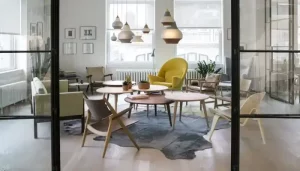The concept of sustainable home design has become increasingly important in today’s world. As we become more aware of the impact our homes have on the environment, there’s a growing desire to create living spaces that are eco-friendly and resource-conscious. Sustainable home design isn’t just about saving the planet, it’s also about creating healthy, comfortable, and cost-effective living environments for ourselves and future generations.

Why Sustainable Home Design Matters
There are numerous compelling reasons to embrace sustainable home design principles:
- Environmental Benefits: Sustainable homes reduce our reliance on non-renewable resources like fossil fuels and minimize our carbon footprint. This helps combat climate change and protects our natural ecosystems.
- Healthier Living: Sustainable homes often prioritize improved indoor air quality through the use of natural materials and ventilation systems. This can lead to better health for occupants, reducing respiratory issues and allergies.
- Energy and Water Savings: Sustainable features like energy-efficient appliances and water-conserving fixtures can significantly reduce utility bills. This translates to cost savings for homeowners over the long term.
- Increased Property Value: Sustainable homes are becoming increasingly desirable in the real estate market. Homes with sustainable features often command higher prices and sell faster than traditional homes.
By incorporating sustainable practices into your home design, you’re not just making a statement, you’re making a positive impact on the planet, your wallet, and your well-being.
Embracing Energy Efficiency
Energy efficiency is a cornerstone of sustainable home design. Here are some key features to consider:
- Solar Panels and Renewable Energy Sources: Harnessing the power of the sun with solar panels is a fantastic way to generate clean, renewable energy for your home. This can significantly reduce your reliance on the grid and lower your electricity bills.
- Energy-Efficient Appliances: Look for appliances with Energy Star certifications. These appliances are significantly more efficient than traditional models, consuming less energy to operate.
- LED Lighting and Smart Lighting Systems: Replace traditional incandescent bulbs with LED lights. LEDs use a fraction of the energy and last much longer. Smart lighting systems allow you to control lights remotely and automate lighting based on occupancy, further reducing energy consumption.
Passive Design Strategies: Working with Nature
Sustainable design goes beyond just adding technology. Passive design strategies take advantage of natural elements to create a comfortable and energy-efficient living environment:
- Orientation and Layout for Natural Light and Ventilation: Design your home to maximize natural light intake. Strategically placed windows and skylights can brighten your home and reduce the need for artificial lighting. Consider cross-ventilation to promote natural air circulation and reduce reliance on air conditioning.
- Use of Natural and Local Materials: Whenever possible, use natural and local materials like sustainably harvested wood, bamboo, and recycled content. This reduces the environmental impact associated with transportation and manufacturing.
- Insulation and Thermal Mass Considerations: Proper insulation keeps your home warm in the winter and cool in the summer, reducing your heating and cooling needs. Thermal mass materials like brick, concrete, and stone can absorb and retain heat, helping to regulate indoor temperatures naturally.
Water Conservation Techniques
Water is a precious resource, and sustainable homes prioritize its conservation:
- Low-Flow Fixtures and Faucets: Install low-flow faucets, showerheads, and toilets. These fixtures use significantly less water without compromising performance.
- Rainwater Harvesting Systems: Capture rainwater from your roof and store it in a cistern. This recycled water can be used for irrigation, laundry, or even toilet flushing.
- Greywater Recycling Systems: Greywater is wastewater from sinks, showers, and washing machines that can be treated and reused for non-potable purposes like watering plants or flushing toilets.
Breathing Easy: Indoor Air Quality Enhancements
The air quality inside your home significantly impacts your health and well-being. Sustainable home design prioritizes creating a healthy indoor environment:
- Use of Low-VOC Paints and Finishes: Volatile Organic Compounds (VOCs) emitted from paints, finishes, and furniture can pollute indoor air. Choose low-VOC or VOC-free products to minimize these emissions.
- Natural Ventilation Systems: Proper ventilation is crucial for removing pollutants and stale air from your home. Utilize natural ventilation strategies like opening windows and doors regularly. Consider whole-house ventilation systems for a more controlled approach.
- Indoor Plants for Air Purification: Certain houseplants are natural air purifiers. Plants like snake plants, spider plants, and peace lilies can help remove toxins from the air and improve indoor air quality.
Creating a Harmonious Outdoor Space
Sustainable practices extend beyond the walls of your home. Consider these landscaping techniques:
- Native Plant Species for Landscaping: Opt for native plants that are adapted to your climate. They require less water and are more resistant to pests and diseases, reducing the need for pesticides and fertilizers.
- Permeable Surfaces for Rainwater Infiltration: Use permeable surfaces like gravel, pavers, or bioswales instead of traditional concrete for walkways and patios. This allows rainwater to infiltrate the ground, replenishing groundwater reserves and reducing stormwater runoff.
- Drought-Resistant Landscaping Techniques: Employ drought-resistant landscaping techniques like mulching around plants to retain moisture. This reduces the need for watering, conserving water, and saving money.
Technology for Sustainability: Smart Solutions
Technology can play a significant role in monitoring and managing your home’s energy and water use:
- Smart Home Systems for Energy and Resource Management: Smart home systems allow you to control lighting, thermostats, and appliances remotely. This enables you to optimize energy and water usage and identify areas for improvement.
- Monitoring Systems for Energy and Water Usage: Install monitoring systems to track your home’s energy and water consumption in real-time. This data can help you identify usage patterns and make adjustments to conserve resources.
- Apps and Devices for Sustainable Living Practices: Numerous apps and devices are available to help you live more sustainably. These tools can track your energy and water usage, provide tips for reducing waste, and connect you with local sustainable resources.
Investing in Sustainability: Cost Considerations and Returns
Sustainable home design might involve higher upfront costs for certain features like solar panels or energy-efficient appliances. However, these investments often pay off in the long run:
- Initial Costs versus Long-Term Savings: While the initial cost of some sustainable features might be higher, the long-term savings on energy and water bills can be significant. Additionally, maintenance costs for sustainable features are often lower.
- Government Incentives and Rebates for Sustainable Home Features: Many governments offer incentives and rebates to encourage homeowners to adopt sustainable practices. Research available programs and financial assistance options in your area.
- Increased Property Value and Market Demand for Sustainable Homes: Homes with sustainable features are becoming increasingly desirable in the real estate market. Sustainable homes often command higher prices and sell faster than traditional homes.
By carefully considering the cost-benefit analysis, you can make informed decisions about incorporating sustainable features into your home design. In many cases, the financial returns on your investment can be substantial.
Sustainable Aesthetics: Trends in Interior Design
Sustainable design principles extend to the aesthetics of your home as well:
- Minimalistic and Functional Designs: Minimalistic design emphasizes clean lines, uncluttered spaces, and multi-functional furniture. This reduces the need for excess materials and promotes a sense of calmness and order.
- Use of Reclaimed and Upcycled Materials: Incorporate reclaimed wood, vintage furniture, and upcycled materials into your design. This not only adds character and uniqueness to your space but also reduces environmental impact by giving new life to existing materials.
- Integration of Nature-Inspired Elements: Bring the outdoors in by incorporating natural elements like wood, stone, and plants. Use natural light whenever possible and create a connection between your living space and the natural world.
Sustainable design doesn’t have to be bland or boring. By embracing these trends, you can create a beautiful, functional, and eco-conscious home that reflects your personality and values.
Conclusion
In conclusion, sustainable home design isn’t just a trend—it’s a necessity for a better future. By embracing energy efficiency, passive design strategies, water conservation techniques, and sustainable landscaping, we can create homes that are healthier for both us and the planet.
Integrating technology and considering cost savings and returns make sustainable choices practical and rewarding. With minimalist aesthetics and a focus on reclaimed materials, sustainable homes can be stylish and unique. Let’s work together to build homes that not only reflect our values but also contribute to a more sustainable world for generations to come.


